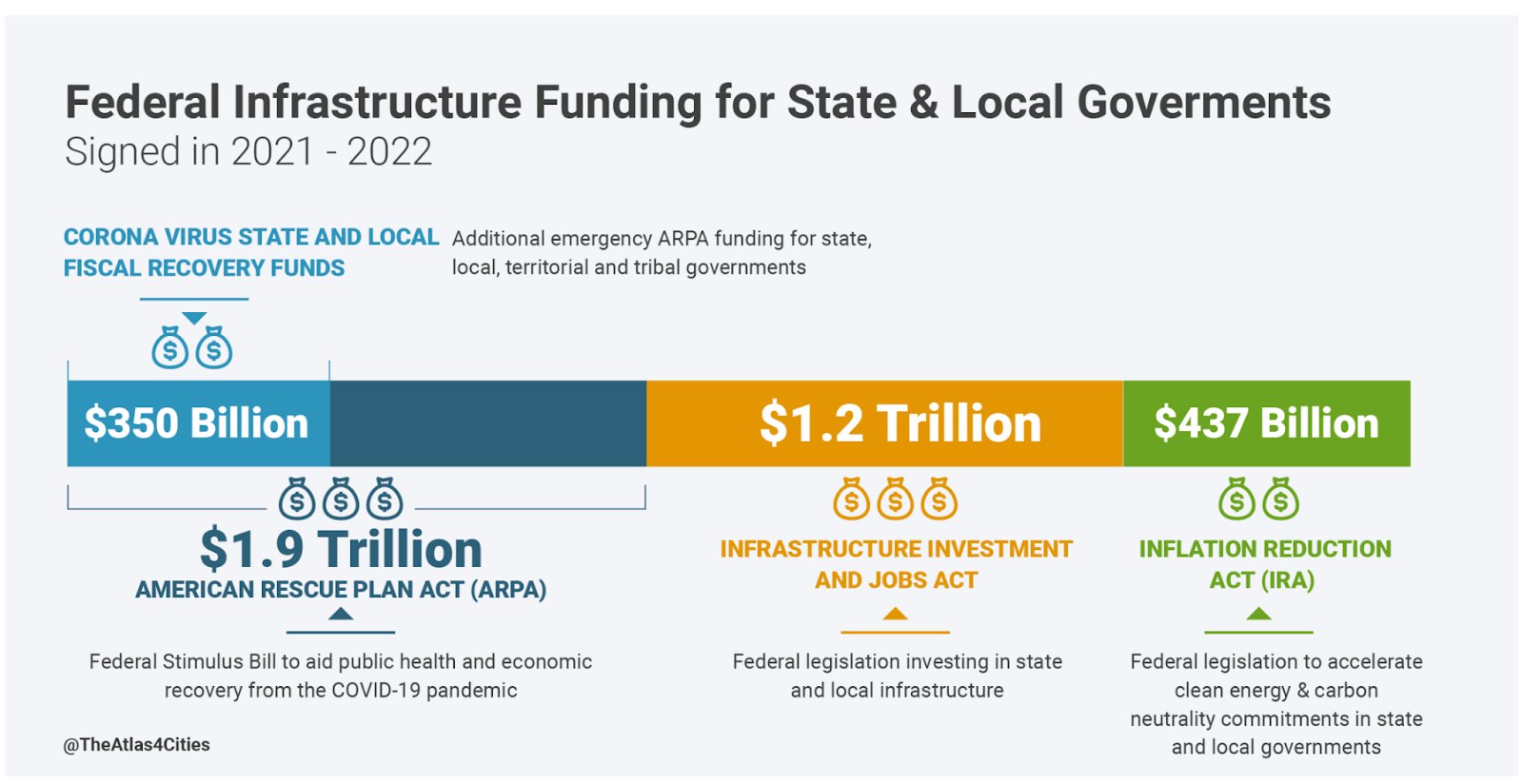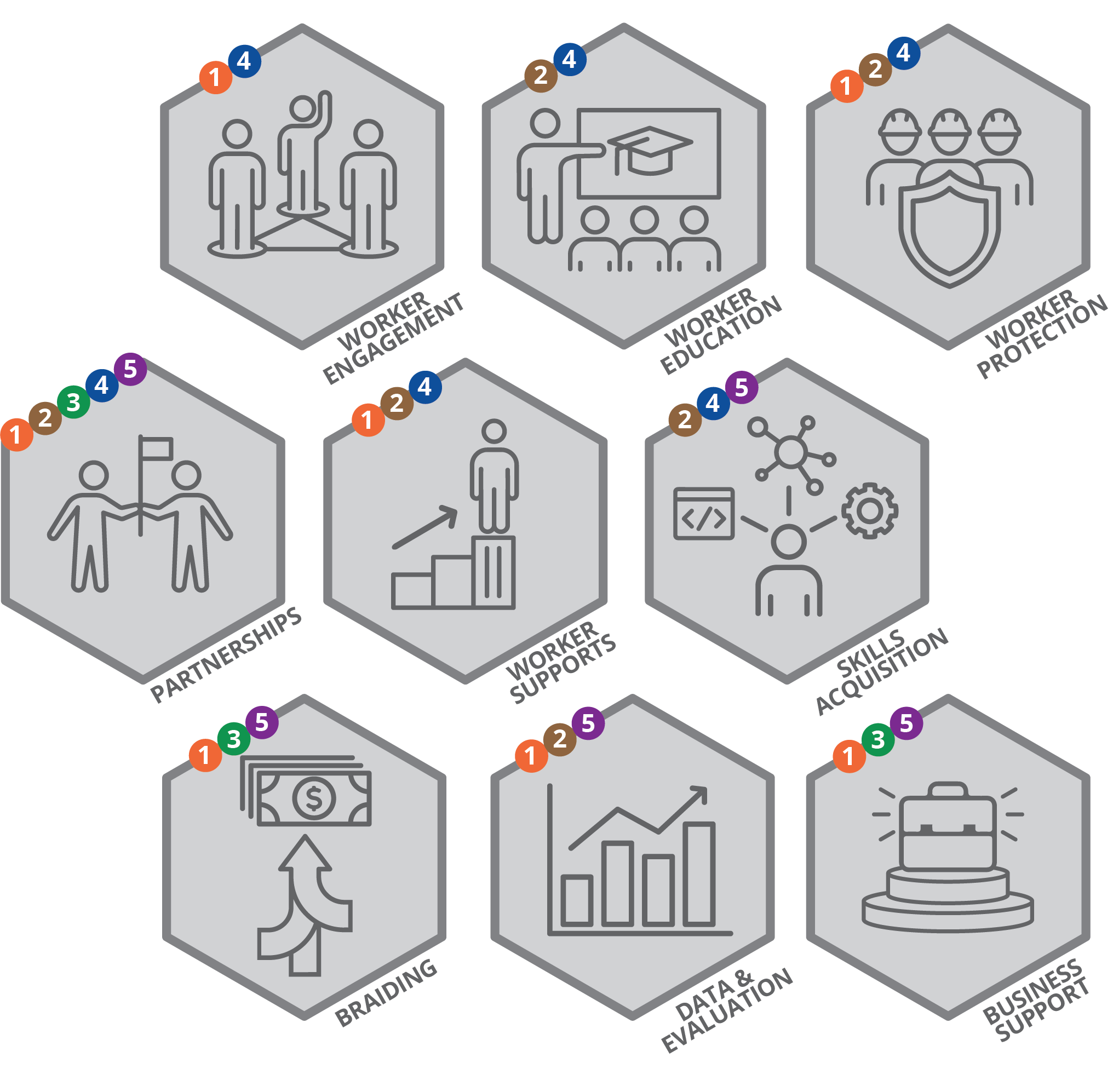Infrastructure Funding At a Glance
BIL funding is being distributed over a multiyear process primarily through the Department of Transportation, Department of Energy and the Department of Commerce, as well as the Environmental Protection Agency. This builds on the investment previously made through the American Rescue Plan and its accompanying pandemic recovery support. It also sits alongside climate and clean energy investments, some of which touch infrastructure, being made through the IRA and include climate change mitigation and deficit reduction. At its core, BIL funding supports training programs in construction and related trades to further the transformation of domestic infrastructure and create good jobs for underserved communities. IRA provides funding for clean energy, workforce development and environmental justice programs with a focus on disadvantaged communities.
There is “approximately $4.5 billion in the IRA that could be used for workforce or occupation-specific training,” but much of that funding is in the form of clean energy tax credits or is one-time funding only. More than 60 percent of the funding in BIL will be distributed via formulas to states and other recipients, while a subset of the remaining funds are available directly to communities via discretionary grants. The structure of the BIL and IRA funding makes it critically important for cities to work closely with their states to align priorities and advocate for their local needs. However, cities can use many of these same concepts around job quality and equity to guide their applications for direct federal funding. Both funding streams cut across multiple sectors in their implementation and deployment.
Pursuing and Securing the Funding
Funding Focus Areas for Successful Pursuits
Successful applications for competitive infrastructure funding should address a number of focus areas related to workforce development. The following sections provide steps and examples to support city leadership with the information to succeed in each of these areas:
- Engaging underserved communities to ensure they benefit from the investments being made
- Embedding a set of workforce development strategies for education, skill acquisition and support in the plan or proposal to invest in training, create jobs, uplift small businesses, or create the policy and enforcement infrastructure to protect workers
- Understanding and aligning with the equity and job quality elements to protect workers
- Connecting into the workforce ecosystem, particularly unions, and tapping into strategic partnerships to advance the work
- Braiding and leveraging various funding to maximize results
- Outlining a plan for collecting data and evaluating results to understand the project’s impact on jobs, infrastructure, and equity
In developing a funding proposal, cities will see many of the focus areas below show up as practices that are either required or preferred for grant submissions. Use the section below to assist you in addressing these practices in your submission. To see the text of a specific NOFO, click for more information.
- Partnership
- Braiding Funding
- Worker Engagement
- Worker Supports
- Worker Education
- Skills Acquisition
- Business Support
- Worker Protection
- Monitoring and Evaluation
Use of union/labor partnerships (Some applications may request letters of support.)
- Strategy 1 Program Design (Earn and Learn Models)
Partnerships with workforce development boards, educators or the workforce system
Leveraging various funding sources to support delivery or workforce development programs or supports
Recruiting and hiring from underserved communities within a given locality
- Strategy 2 Policy (Community Benefits Agreements)
- Strategy 3 Procurement
Engaging local areas in dialogue to understand needs, better direct benefits, design workforce programs and protect workers
- Strategy 2 Policy (Community Benefits Agreements)
- Strategy 4 Enforcement (Worker Boards)
Identifying underserved representatives and how to serve them
- Strategy 5 Monitoring and Evaluation (Logic Model)
Providing supportive services to remove barriers for underserved populations
- Strategy 1 Program Design (Supportive Services & Essential Skills)
Educating workers on their rights, including but not limited to free and fair choice to join a union, worker organizing and empowerment, and reporting mechanisms, as well as whistleblower protections
- Strategy 4 Education and Enforcement (Strategic Enforcement & Worker Education)
Using existing, proven or scale-ready registered pre-apprenticeships and apprenticeship programs or creation of new programs where gaps exist to connect workers with good jobs
- Strategy 1 Program Design (Earn and Learn Models)
- Strategy 2 Policy (Project Labor Agreements & Local Hire Agreements)
- Job Quality and Equity Framework
Professional skill development for new hires and incumbent workers to assist in creating pathways to good jobs
- Strategy 1 Program Design(Occupational Skills & Essential Skills)
- Job Quality and Equity Framework
Local inclusive economic development and wealth creation
- Strategy 1 Program Design (Business Support)
- Job Quality and Equity Framework
Support for and partnership with Small and Midsize Businesses (SMB), Small Disadvantaged Businesses (SDBs) and Service-Disabled Veteran-Owned Businesses, Minority-owned businesses, Women-owned Businesses, or 8(a) firms and other socially and economically disadvantaged businesses
- Strategy 1 Program Design (Business Support)
- Strategy 3 Procurement
Addressing Davis-Bacon requirements and ensuring workers are aware of their wage, classification and fringe benefits
- Strategy 2 Policy (Living Wage)
- Strategy 4 Education and Enforcement (Strategic Enforcement & Worker Education)
Providing predictable and stable work schedules
Using project labor agreements and community benefits agreements, either as part of application or in procurement or other compliance processes
- Strategy 2 Policy (Local Hire Agreements & Community Benefits Agreements)
- Strategy 3 Procurement
- Strategy 4 Education and Enforcement (Strategic Enforcement & Worker Education)
Ensuring vendors or subrecipients will apply the same standards
- Strategy 3 Procurement
- Strategy 4 Education and Enforcement (Strategic Enforcement & Worker Boards)
Creating and maintaining safe and healthy working conditions including but not limited to adherence to safety plans, OSHA, anti-discrimination and anti-harassment protections and reporting, worker organizing and voice, classification, and equal opportunity.
- Strategy 4 Education and Enforcement (Strategic Enforcement & Worker Education)
- Job Quality and Equity Framework
Protecting workers while on the job / prior compliance with labor standards and plans for future compliance of companies
- Strategy 4 Education and Enforcement (Strategic Enforcement)
BIL, IRA and other federal funding opportunities generally address workforce development in the following ways, which are provided as an example. A single grant may include one or more of these approaches. See a detailed review of 25+ NOFOs including their corresponding excerpts on workforce development for more examples.
| Approach | Samples |
| Dollars allocated directly to workforce functions | |
| Workforce explicitly called out as an eligible use of funding | |
| Equity and good jobs mentioned as a core goal | |
| Equity or good jobs included in the evaluation criteria or eligible considerations | |
| Partnership with workforce development required or encouraged |
Review Advancing Equitable Workforce Development for Infrastructure Jobs, Center for Transportation Workforce Development as well as the Rural Infrastructure Playbook for more details.




